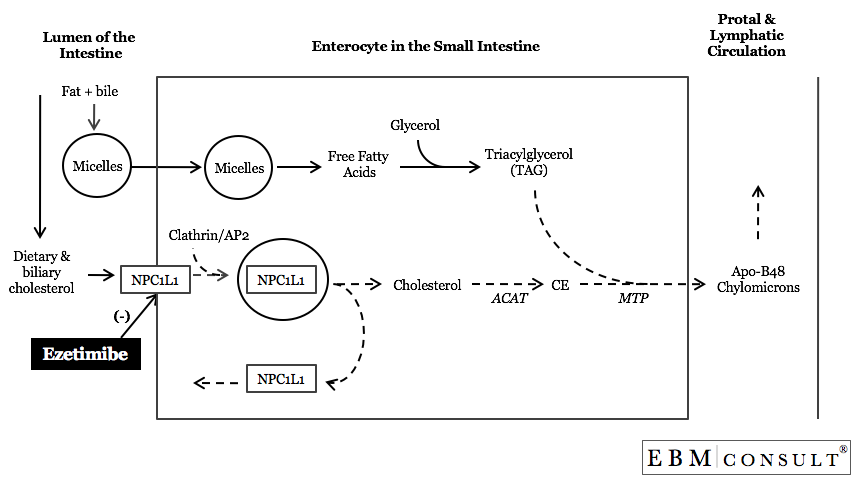Ezetimibe
(Zetia) is the first cholesterol absorption inhibitor that can primarily reduce
low density lipoprotein cholesterol (LDL-C), either as monotherapy, in
combination with HMG CoA reductase inhibitor (statin) therapy, in combination
with fenofibrate, or in patients with homozygous familial hypercholesterolemia
on either atorvastatin or simvastatin and in patients with homozygous
sitosterolemia.1-5 It has been especially useful in helping some patients
with significant hyperlipidemia to get to their individualized LDL-C goals when
max doses of statins have been tried.6 Ezetimibe's is able to inhibit
cholesterol absorption by 54%, which contributes to the net 18-20% reductions
in LDL-C seen in lipid profiles.7 It is important to note that this
improvement in LDL-C is done without any compensatory increases in triglyceride
concentrations, as seen with bile acid binding resins (or bile acid
sequestrants such as cholestyramine, colesevelam) and without an increased risk
for developing gallstones, as sometimes seen with fibrates (fenofibrate and
gemfibrozil).8-10

How
does cholesterol get absorbed into the body?
It is first critical to understand the basic steps involved
for both dietary and biliary cholesterol in the small intestine.11,12
Cholesterol absorption takes place in the small intestine and through a number
of processes.13 Regardless of whether the free cholesterol came from
dietary sources or from bile, it first binds to Niemann-Pick C1-like 1 (NPC1L1)
protein located in the plasma membrane on the luminal side of the enterocyte in
the small intestine.11-13 NPC1L1 and the bound cholesterol then bind to
clathrin/AP2 so that the bound complex can undergo vesicular endocytosis within
the enterocyte.14,15 Clathrin and AP2 are important for the formation of
small vesicles that undergo endocytosis and are important to intracellular pathways
(vesicular trafficking) that interact with the plasma membrane. Without
clathrin/AP2 activity the endocytosis (or delivery) of NPC1L1 and cholesterol
would not occur.
Upon
endocytosis of NPC1L1 and bound cholesterol, the cholesterol is released and
the NPC1L1 is released to be returned back to the plasma membrane for
additional cholesterol binding/absorption.15 The released cholesterol
into the cytosol is then esterified by acyl-coenzyme A:cholesterol
acyltransferase (ACAT) to form cholesterol esters.16 The newly formed
cholesterol esters then combine with triacylglycerol particles (from absorbed
free fatty acids) through the facilitation by microsomal triacylglycerol
transfer protein (MTP) to form ApoB-48 containing chylomicrons.16 The
newly formed Apo-B48 containing chylomicrons will then taken up into the portal
or lymphatic circulation for the liver and body to use.16
How
does ezetimibe actually decrease cholesterol absorption from the intestine that
results in these improvements in the lipid profile?
Ezetimibe and its main metabolite, ezetimibe glucuronide, prevent the
absorption of cholesterol by directly binding to a transmembrane loop for
NPC1L1, thereby inhibiting its ability to bind with clathrin/AP2 that is
required for its endocytosis.15 Since the NPC1L1 /cholesterol complex
cannot be internalized, cholesterol cannot then be brought into the enterocyte
to form the initial ApoB-48 containing chylomicrons that go into
circulation. This results in the net decreases of 18-20% in LDL-C on a
patient's lipid profile.
References:
- Bays HE, Moore PB, Drehobl MA et al. Effectiveness and tolerability
of ezetimibe in patients with primary hypercholesterolemia: pooled
analysis of two phase II studies. Clin Ther 2001;23:1209-30.
- Davidson
MH, McGarry T, Bettis R et al. Ezetimibe coadministered with
simvastatin in patients with primary hypercholesterolemia. J Am Coll
Cardiol 2002;40:2125-34.
- Ballantyne
CM, Houri J, Notarbartolo A et al. Effect of ezetimibe coadministered
with atorvastatin in 628 patients with primary hypercholesterolemia: a
prospective, randomized, double-blind trial. Circulation
2003;107:2409-15.
- Ballantyne
CM, Blazing MA, King TR et al. Efficacy and safety of ezetimibe
co-administered with simvastatin compared with atorvastatin in adults
with hypercholesterolemia. Am J Cardiol 2004;93:1487-94.
- Ezetimibe (Zetia®) product package insert. Merck/Schering-Plough Pharmaceuticals. North Wales, PA. May 2009.
- Feldman
T, Koren M, Insull W Jr et al. Treatment of high-risk patients with
ezetimibe plus simvastatin co-administration versus simvastatin alone to
attain National Cholesterol Edcuation Program Adult Treatment Panel III
low-density lipoprotein cholesterol goals. Am J Cardiol
2004;93:1481-6.
- Sudhop
T, Lutjohann D, Kodal A et al. Inhibition of intestinal cholesterol
absorption by ezetimibe in humans. Circulation 2002;106:1943-8.
- Insull
W Jr, Davidson MH, Demke DM et al. The effects of colestipol tablets
compared with colestipol granules on plasma cholesterol and other lipids
in moderately hypercholesterolemic patients. Atherosclerosis
1995;112:223-35.
- Watanabe
M, Houten SM, Wang L et al. Bile acids lower triglyceride levels via a
pathway involving FXR, SHP, and SREBP-1c. J Clin Invest
2004;113:1408-18.
- McKenney
JM, Farnier M, Lo KW et al. Safety and efficacy of long-term
co-administration of fenofibrate and ezetimibe in patients with mixed
hyperlipidemia. J Am Coll Cardiol 2006;47:1584-7.
- Altmann
SW, Davis HR Jr, Zhu LJ et al. Niemann-Pick C1 Like 1 protein is
critical for intestinal cholesterol absorption. Science
2004;303:1201-4.
- Davies
JP, Scott C, Oishi K et al. Inactivation of NPC1L1 causes multiple
lipid transport defects and protects against diet-induced
hypercholesterolemia. J Biol Chem 2005;280:12710-20.
- Sane
AT, Sinnett D, Delvin E et al. Localization and role of NPC1L1 in
cholesterol absorption in human intestine. J Lipid Res
2006;47:2112-20.
- Chang TY, Chang C. Ezetimibe blocks internalization of the NPC1L1/cholesterol complex. Cell Metab 2008;7:469-71.
- Wang
J, Chu BB, Ge L et al. Membrane topology of human NPC1L1, a key
protein in enterohepatic cholesterol absorption. J Lipid Res
2009;[Epub ahead of print].
- Choi
BG, Badimon JJ, Moreno PR et al. Lipoprotein metabolism and vascular
biology. In: Therapeutic Lipidology. Davidson MH, Toth PP, Maki KC
eds. Human Press. Totowa, NJ. 1-22.


